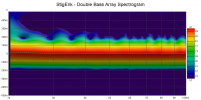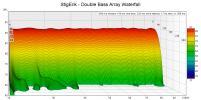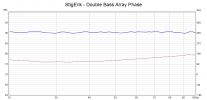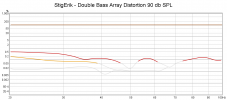After seeing the visualisations quoted below, I agree, because the "back wave" of the rear woofers is "uncancelled". If the front speakers were off the wall the same distance, then maybe it would balance out (but also the decay side would look worse)? And if one or both were close to the walls (thin boxes), then maybe the "back wave" is close enough in time and phase to not matter?IMO this will not work
-
WANTED: Happy members who like to discuss audio and other topics related to our interest. Desire to learn and share knowledge of science required. There are many reviews of audio hardware and expert members to help answer your questions. Click here to have your audio equipment measured for free!
You are using an out of date browser. It may not display this or other websites correctly.
You should upgrade or use an alternative browser.
You should upgrade or use an alternative browser.
Simulation Overview of the 'Double Bass Array' Configuration.
- Thread starter René - Acculution.com
- Start date
I believe you are correct. If the second (rear) set of bass radiators are not mounted right at the rear wall, while they can cancel the waves from the front bass radiators, the front wall reflections of the rear bass radiators become the new problem. Below is the simulation of placing the second set of bass radiators in the middle of the room. (To make the problem less computationally intensive, the room was modeled as a narrow room with 1 front and 1 rear radiators.) You can see that initially the waves from the front radiator were effectively cancelled by the second radiator. However, as the waves from the second radiator going towards the front wall get reflected back, there is no cancelation for them, and they can excite room modes just like regular bass radiators.After seeing the visualisations quoted below, I agree, because the "back wave" of the rear woofers is "uncancelled". If the front speakers were off the wall the same distance, then maybe it would balance out (but also the decay side would look worse)? And if one or both were close to the walls (thin boxes), then maybe the "back wave" is close enough in time and phase to not matter?
When the front wall was modeled with a very high absorption coefficient, whilst the other walls remain highly reflective, the problem sort of went away. However, you also can see standing waves being formed!
The problem is also avoided with the standard double bass array configuration of wall mounting the bass radiators, without a non-reflective front wall.
- Joined
- May 1, 2021
- Messages
- 427
- Likes
- 1,309
- Thread Starter
- #83
I got curious about the case of 2x2 subs, but placed halfway up the wall (if anyone is actually doing that in practice). It is actually still a quite good result. The subs are still placed inside the wall to have the perfect alignment, so any deviation from that will of course modify the response.

Btw, did anyone catch the Audioholics/Trinnov video recently? I haven't had time to look into what they actually do, but presumably something more complex than this.
Btw, did anyone catch the Audioholics/Trinnov video recently? I haven't had time to look into what they actually do, but presumably something more complex than this.
I watched the Shane Lee YT video Trinnov "WaveForming" update by Jon Herron, and am highly unimpressed. See my comments in the post below:Btw, did anyone catch the Audioholics/Trinnov video recently? I haven't had time to look into what they actually do, but presumably something more complex than this.

Different approaches to managing bass
I'll have to say I am skeptical. IMHO, there are plenty of misleading and questionable information in the YT vid. Jon Herron said that the "traditional" multi-sub approach "flood" the zone with multiple sources and no control creates "overlapping modes". What exactly does that mean? Does MSO or...
 www.audiosciencereview.com
www.audiosciencereview.com
They mischaracterize MSO/SFM (if they count them as "traditional approached") as "flooding the zone" with "overlapping modes". And I highly doubt that with only 3 or 4 subs placed basically randomly on the front wall, they can beam steer effectively to be called "waveforming".
- Joined
- May 1, 2021
- Messages
- 427
- Likes
- 1,309
- Thread Starter
- #85
Thank you. I just watched a piece of the other video with burst from two subs that apparently just propagate but the mathematics is not there so it is hard to follow. And as you write, the modes are there regardless of the sourcing.I watched the Shane Lee YT video Trinnov "WaveForming" update by Jon Herron, and am highly unimpressed. See my comments in the post below:

Different approaches to managing bass
I'll have to say I am skeptical. IMHO, there are plenty of misleading and questionable information in the YT vid. Jon Herron said that the "traditional" multi-sub approach "flood" the zone with multiple sources and no control creates "overlapping modes". What exactly does that mean? Does MSO or...www.audiosciencereview.com
They mischaracterize MSO/SFM (if they count them as "traditional approached") as "flooding the zone" with "overlapping modes". And I highly doubt that with only 3 or 4 subs placed basically randomly on the front wall, they can beam steer effectively to be called "waveforming".
Last edited:
Not sure if you've seen this, but in case you haven't, Celestinos has done some work on this configuration and published it in his Ph.D thesis. He calls the configuration "CABS".I got curious about the case of 2x2 subs, but placed halfway up the wall (if anyone is actually doing that in practice). It is actually still a quite good result.
- Joined
- May 1, 2021
- Messages
- 427
- Likes
- 1,309
- Thread Starter
- #87
Yes I worked in the same company as him as we did or had done our PhDs, and he also demonstrated it.Not sure if you've seen this, but in case you haven't, Celestinos has done some work on this configuration and published it in his Ph.D thesis. He calls the configuration "CABS".
@andyc56
Im going to hijack this thread real quick, Ive been looking for your email but have not found it online. I would love to help do a plugin/exporter for MSO that can export a complete MiniDSP config xml. I have some scripts that can parse the exported biquad files and convert to XML,but I think it would be really convinient if it could be done in MSO directly.
Im going to hijack this thread real quick, Ive been looking for your email but have not found it online. I would love to help do a plugin/exporter for MSO that can export a complete MiniDSP config xml. I have some scripts that can parse the exported biquad files and convert to XML,but I think it would be really convinient if it could be done in MSO directly.
Based on the videos, newsletters, and conversation with Jon/Trinnov, their new approach is similar to a phased-array scheme akin to antenna arrays. Not sure how similar to your approach that is, have not had time to read through it all, but at first blush seems similar... I proposed something like a phased array of subs many years ago, when I was working with radar systems, but never had the time and horsepower to take it further.I got curious about the case of 2x2 subs, but placed halfway up the wall (if anyone is actually doing that in practice). It is actually still a quite good result. The subs are still placed inside the wall to have the perfect alignment, so any deviation from that will of course modify the response.
View attachment 307011
Btw, did anyone catch the Audioholics/Trinnov video recently? I haven't had time to look into what they actually do, but presumably something more complex than this.
- Joined
- May 1, 2021
- Messages
- 427
- Likes
- 1,309
- Thread Starter
- #90
Thanks, perhaps it is similar to that. And BTW, nothing here is 'my' approach, I have made no contributions to this particular field.Based on the videos, newsletters, and conversation with Jon/Trinnov, their new approach is similar to a phased-array scheme akin to antenna arrays. Not sure how similar to your approach that is, have not had time to read through it all, but at first blush seems similar... I proposed something like a phased array of subs many years ago, when I was working with radar systems, but never had the time and horsepower to take it further.
Disseminating the information is a contribution to us, my thanks.Thanks, perhaps it is similar to that. And BTW, nothing here is 'my' approach, I have made no contributions to this particular field.
Very interesting thread! Thanks a lot.
I have built a DBA with 24 subwoofers in a rectangular room with sloped ceiling. With some EQ tweaking on the rear array, the result is quite amazing. I will present some measurements later on.
I have built a DBA with 24 subwoofers in a rectangular room with sloped ceiling. With some EQ tweaking on the rear array, the result is quite amazing. I will present some measurements later on.
In my opinion, the most interesting thing with a DBA is how short and clean the decay can become, even in a non-optimal space. My room is about 5 x 7 meters, with an average ceiling height of 3 meters. It's a cathedral ceiling with about 2,7 meters height at the front and rear of the room, and 3,3 meters at the center. There is a concrete floor, all four walls have double layer of gypsum board and are quite stiff. The ceiling is just a single layer of pine wood plank.
There is also furniture and five very large open baffle dipole speakers in the room that will disturb the plane wave within the room. I have no low frequency absorption at all inside the room. Anyway - with a lot of EQ tweaking on the rear array, the result is quite amazing. The bass sounds like in headphones, but with great physical impact.
As mentioned, the are a total of 24 woofers - a 3 by 4 array on both front and rear walls. They are SEAS L26ROY in 35 liter closed boxes. Amps: Three ICEpower 2000AS2. DSP: MiniDSP Flex.
The attached measurements are all done in the main listening position, which almost exactly in the center of the room.
There is also furniture and five very large open baffle dipole speakers in the room that will disturb the plane wave within the room. I have no low frequency absorption at all inside the room. Anyway - with a lot of EQ tweaking on the rear array, the result is quite amazing. The bass sounds like in headphones, but with great physical impact.
As mentioned, the are a total of 24 woofers - a 3 by 4 array on both front and rear walls. They are SEAS L26ROY in 35 liter closed boxes. Amps: Three ICEpower 2000AS2. DSP: MiniDSP Flex.
The attached measurements are all done in the main listening position, which almost exactly in the center of the room.
Attachments
That's a dream system and downright beats Trinnov Waveforming looking at the waterfalls. I have only seen such smooth and clean spectrogram when "hypothetically" convolving time inverted response with itself in REWIn my opinion, the most interesting thing with a DBA is how short and clean the decay can become, even in a non-optimal space. My room is about 5 x 7 meters, with an average ceiling height of 3 meters. It's a cathedral ceiling with about 2,7 meters height at the front and rear of the room, and 3,3 meters at the center. There is a concrete floor, all four walls have double layer of gypsum board and are quite stiff. The ceiling is just a single layer of pine wood plank.
There is also furniture and five very large open baffle dipole speakers in the room that will disturb the plane wave within the room. I have no low frequency absorption at all inside the room. Anyway - with a lot of EQ tweaking on the rear array, the result is quite amazing. The bass sounds like in headphones, but with great physical impact.
As mentioned, the are a total of 24 woofers - a 3 by 4 array on both front and rear walls. They are SEAS L26ROY in 35 liter closed boxes. Amps: Three ICEpower 2000AS2. DSP: MiniDSP Flex.
The attached measurements are all done in the main listening position, which almost exactly in the center of the room.
How did you you power 24 woofers with just 3 amps? How did you hang 35 liter boxes all over the walls?
I use two 2-channel amps on the front array. Each amp channel is driving three 4 ohm woofers connected in series.
The rear array require less power, so I use a single 2-channel amp there, each channel driving six 4 ohm woofers.
How to hang such an array? Hooks and rope, hung from the ceiling.
The rear array require less power, so I use a single 2-channel amp there, each channel driving six 4 ohm woofers.
How to hang such an array? Hooks and rope, hung from the ceiling.
I.if anyone is actually doing that in practice
What's crazy is this is $12K just for the drivers (at US prices) but I wouldn't even say it's a bad value. People spend much more on worse stuff. The drivers are expensive but high quality. I was looking at sub drivers a while back and I think these are the best you can get before the price/performance ratio gets very bad... Hats off...As mentioned, the are a total of 24 woofers - a 3 by 4 array on both front and rear walls. They are SEAS L26ROY in 35 liter closed boxes. Amps: Three ICEpower 2000AS2. DSP: MiniDSP Flex.
Keith_W
Major Contributor
Based on the videos, newsletters, and conversation with Jon/Trinnov, their new approach is similar to a phased-array scheme akin to antenna arrays. Not sure how similar to your approach that is, have not had time to read through it all, but at first blush seems similar... I proposed something like a phased array of subs many years ago, when I was working with radar systems, but never had the time and horsepower to take it further.
I tried creating a phased array after I watched that video several months ago. The formula for calculating the phase shift for a desired angle is 2 * pi (d/lambda) * sin theta; where d = array spacing, lambda = wavelength, and theta = desired angle.
In my case, I wanted to steer the bass and dump the excess into an adjoining dining room on the left of the MLP. So I used Acourate to keep the left sub unchanged, phase shifted the right sub by what I calculated, and took some before / after measurements in the MLP and in the dining room.

I kept quiet about it because I did not want ASR to laugh at me even more than they already do. This measurement was taken from the dining room of the sub only, and shows three curves overlaid on top of each other. The first curve is uncorrected, the second is phase shifted, the third was a method I made up myself by delaying one sub with respect to the other:
I don't think you could call that a success. Another hour of my life wasted to another one of my hare brained ideas.
Last edited:
I think you might need to use actual delay for this, if it's going to work at all. Looks like room modes are still fully in charge here.I tried creating a phased array after I watched that video several months ago. The formula for calculating the phase shift for a desired angle is 2 * pi (d/lambda) * sin theta; where d = array spacing, lambda = wavelength, and theta = desired angle.
In my case, I wanted to steer the bass and dump the excess into an adjoining dining room on the left of the MLP. So I used Acourate to keep the left sub unchanged, phase shifted the right sub by what I calculated, and took some before / after measurements in the MLP and in the dining room.

I kept quiet about it because I did not want ASR to laugh at me even more than they already do. This measurement was taken from the dining room of the sub only, and shows three curves overlaid on top of each other. The first curve is uncorrected, the second is phase shifted, the third was a method I made up myself by delaying one sub with respect to the other:

I don't think you could call that a success. Another hour of my life wasted to another one of my hare brained ideas.
Keith_W
Major Contributor
I think you might need to use actual delay for this, if it's going to work at all. Looks like room modes are still fully in charge here.
That's the third method I tried. Summary of the three curves:
1. Control curve. No changes to the DSP.
2. Right sub phase shifted according to the formula.
3. Left sub delayed with respect to the right sub. The delay was obtained by placing the mic at the tip of the red arrow and measuring the arrival of both sub peaks. I then time aligned the left to the right sub with respect to the microphone position, which "should" give me a wavefront heading into the dining room.
I can't remember which curve is which, but that is academic now because all 3 are exactly alike.
Similar threads
- Replies
- 69
- Views
- 5K
- Replies
- 4
- Views
- 552
- Replies
- 4
- Views
- 566
- Replies
- 26
- Views
- 2K




